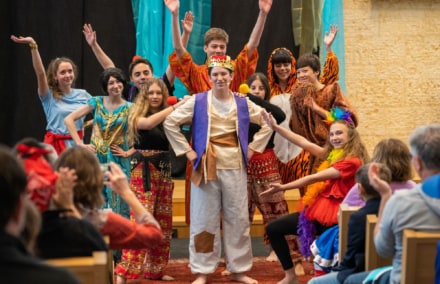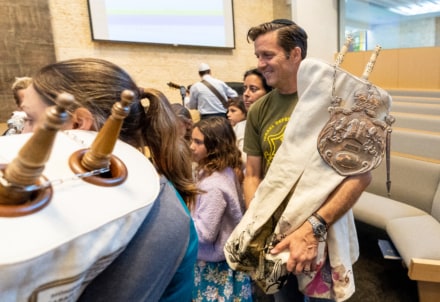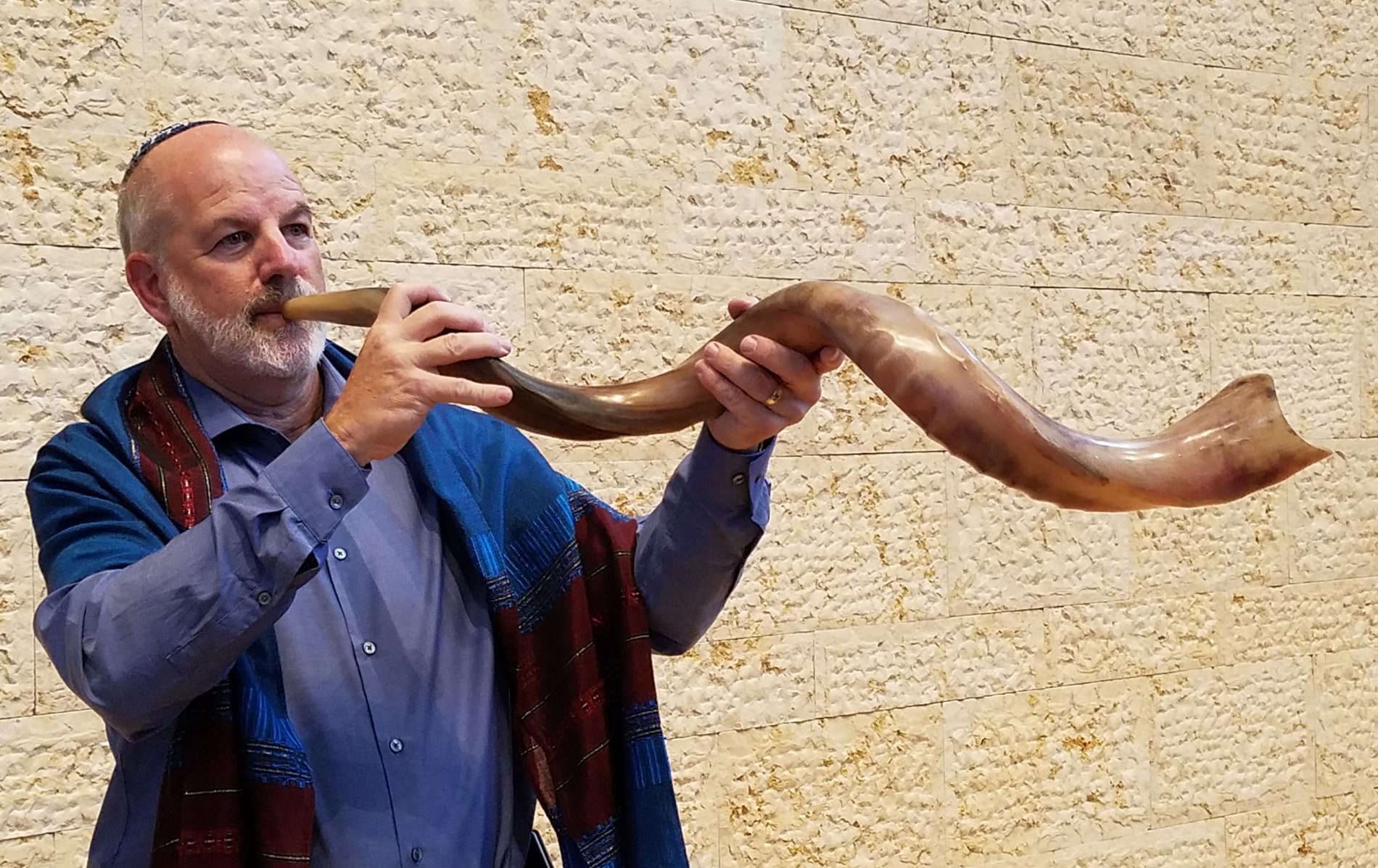We gather as family and community to give thanks, offer respect, and stay connected to the ancient and modern traditions that shape Jewish life and identity.
We invite you to join us for our many celebrations throughout the year!
High Holy Days
Rosh HaShanah and Yom Kippur are two of the most significant times of year for the Jewish people.
Rosh HaShanah marks the beginning of the Jewish year, often associated with sounding the shofar. This special custom is prescribed in the Torah, following the prescription of the Hebrew Bible to “raise a noise.” Other traditions include attending synagogue services; reciting special liturgy about teshuva or repentance; and enjoying apples dipped in honey, in hopes of a sweet new year.
On Yom Kippur, the Jewish Day of Atonement, we fast and look inward to examine our actions since the closure of last year’s gates. We apologize to those whom we wronged, as well as seek forgiveness from God. Yom Kippur provides a unique opportunity for self-reflection and introspection—to honestly assess what we did right and wrong during the previous year, and to commit to repairing the world in the upcoming year.
Sukkot
Sukkot is a joyous celebration of the harvest and a time to remember the Israelites, who wandered in the Sinai desert for 40 years before entering the Promised Land. Some families build a sukkah and reinforce the importance of community by inviting friends and family to join them for meals. Some families sleep under the stars in their sukkah, fully appreciating the shelter of their homes.
Simchat Torah
Simchat Torah literally means “rejoicing with the Torah.” This joyous holiday marks the end of the annual cycle of weekly Torah readings and the beginning of the new cycle. Our community celebrates Simchat Torah by removing all the Torah scrolls from the synagogue ark. Community members hold the scrolls as they sing and dance around the sanctuary in seven circles called hakafot.
Chanukah
Chanukah, also known as the “Festival of Lights,” is a beloved holiday that commemorates the  rededication of the Second Temple in Jerusalem. We celebrate by lighting a Menorah that holds nine flames – one shamash candle (helper) that lights the remaining eight candles. The eight candles represent the number of days oil burned in the destructed temple—despite that oil was only supposed to last one night. We celebrate Chanukah by eating latkes, playing dreidel and exchanging gifts.
rededication of the Second Temple in Jerusalem. We celebrate by lighting a Menorah that holds nine flames – one shamash candle (helper) that lights the remaining eight candles. The eight candles represent the number of days oil burned in the destructed temple—despite that oil was only supposed to last one night. We celebrate Chanukah by eating latkes, playing dreidel and exchanging gifts.
Tu B’Shvat
Tu B’Shvat, or “New Year of the Trees,” is Jewish Arbor Day. The holiday is observed on the 15th (tu) of the Hebrew month of Shvat. Scholars believe that, originally, Tu B’Shvat was an agricultural festival marking the emergence of spring. During the 17th Century, Kabbalists created a ritual for Tu B’Shvat similar to a Passover seder. Today, many Jews hold a modern version of the Tu B’Shvat seder each year. The holiday is now also a tree-planting festival, in which Jews around the world plant trees in Israel in honor or in memory of loved ones and friends.
Purim
Purim is a joyous holiday that celebrates Jewish survival and continuity throughout history. We come together for a communal celebration that involves a public reading of the Book of Esther (M’gillat Esther), which tells the story of the holiday.
 Under the rule of King Ahashverosh, Haman, the king’s adviser, plots to exterminate all the Jews of Persia. Queen Esther and her cousin Mordechai foil his plan and, ultimately, save the Jews of Persia from annhilation. The reading of the m’gillah is a rowdy affair, punctuated by booing and noise-making when Haman’s name is read aloud.
Under the rule of King Ahashverosh, Haman, the king’s adviser, plots to exterminate all the Jews of Persia. Queen Esther and her cousin Mordechai foil his plan and, ultimately, save the Jews of Persia from annhilation. The reading of the m’gillah is a rowdy affair, punctuated by booing and noise-making when Haman’s name is read aloud.
Temple Israel is known for putting on hilarious Purim Shpiels starring talented members of our community. It is not to be missed!
Passover
Passover or Pesach is one of the most beloved Jewish holidays, celebrating freedom and family. The main observances of this holiday center around a seder (meaning “order”). The seder centers around telling the story of the Israelites’ liberation from slavery in ancient Egypt more than 3,000 years ago.
On Passover, we do not eat chametz (food made with leavened grains, including wheat, barley, rye, oats, and spelt). Instead, we eat matzah—an unleavened bread made specially for Passover. We also read from the Haggadah, which guides seder participants through prayers, rituals, readings, and songs. The Haggadah (meaning “telling”) helps us retell the events of the Exodus, so that each generation may learn and remember this story that is so central to Jewish life and history.
Shavuot
The festival of Shavuot celebrates the giving of the Torah at Mount Sinai. It encourages us to embrace the Torah’s teachings and to find inspiration in the wisdom Jewish tradition has to offer.
 Shavuot is the Hebrew word for “weeks,” and the holiday occurs seven weeks after Passover. Shavuot, like many other Jewish holidays, began as an ancient agricultural festival. It marked the end of the spring barley harvest and the beginning of the summer wheat harvest, when Israelites often brought crop offerings to the Temple in Jerusalem. Today, we celebrate the gift of Torah, education on Shavuot, and some make the choice to participate more actively in Jewish life.
Shavuot is the Hebrew word for “weeks,” and the holiday occurs seven weeks after Passover. Shavuot, like many other Jewish holidays, began as an ancient agricultural festival. It marked the end of the spring barley harvest and the beginning of the summer wheat harvest, when Israelites often brought crop offerings to the Temple in Jerusalem. Today, we celebrate the gift of Torah, education on Shavuot, and some make the choice to participate more actively in Jewish life.
Please visit our calendar for dates and times of holiday worship and celebrations.

